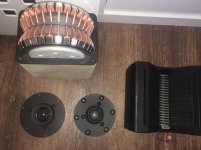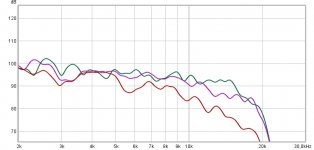For my taste it is a more refined, soft and delicate sound than the ESS, maintaining the character of AMT technology that appeals to me, such as transparency and naturalness. To date the best tweeter I have ever had.
BR
Are the Airblades still around 1000 Euro/each? Also, for some reason, Arya Labs does not state what the sensitivity rating is.
Thanks to the help received here, I managed to sound the ESS very well (for my taste). However, he had long been following the Arya Airblade with interest. Finally, I have acquired a pair that I have already integrated into my loudspeaquers replacing the ESS. Its integration has been easier than the ESS and I have to say that I loved its sound. For my taste it is a more refined, soft and delicate sound than the ESS, maintaining the character of AMT technology that appeals to me, such as transparency and naturalness. To date the best tweeter I have ever had.
BR
Cool. You must be one of the first DIYers building a speaker with Airblade technology! The speaker looks very impressive. How did you acquire your Airblade and what did you have to pay? Is the wide dispersion an issue in your application? At what frequency do you cross over?
Fedde
Last edited:
Hello, after hearing and learning about the airblade in Munich, the desire to have a pair of these tweeters remained in my head. For this I contacted the manufacturer who informed me a few months ago about the start of sales. The cost is high but I don't want to enter into this type of debate. Based on the ATS, I have previously tried the scanspeak of the original Troels G. project, the morel supreme and the ESS. I like all of them a lot and anyone could continue to sound on my systems very well. However, the airblade has seduced me and I think I have reached the end of my particular path regarding my taste in high frequencies.
Regarding the questions asked: the sensitivity should be very similar to the ESS. I have changed very little the resistance circuit.
The cut is at 2200 hz (second order) and I have had no problems with the dispersion of the airblades. I don,t use any correction circuit
BR
Toni
Regarding the questions asked: the sensitivity should be very similar to the ESS. I have changed very little the resistance circuit.
The cut is at 2200 hz (second order) and I have had no problems with the dispersion of the airblades. I don,t use any correction circuit
BR
Toni
Attachments
Comparing the frequency response from the listening point, it strikes me that in my room conditions, the airblade has a more extensive frequency response at high frequencies. (green-airblade, lilac-scanspeak, brown-ESS.) In any case, for me good sound is more than just good graphics
Attachments
Hello, I am reopening this discussion because I purchased in December 2021 a pair of Great Heil Limited edition. i used the last ToniG crossover modified for 1st order, Without L1 and L2, C1=8,2uF . my doubt is about R5 because without this the crossover works very well, Why? I appreciate this LRC circuit, thanks
good morning, I am very happy with the XSim tool. By downloading the file shared by EarlK of the AMT, I have been able to include all the components of the current crossover. It is very interesting
It has caught my attention when I compared the original crossover made by Earlk with the one I have that the answer is practically identical. However, the impedance graph and the slope of the fall of the response curve are very different. The only difference between both crossovers is the Lpad circuit. I use Duelund resistors and they are quite expensive. Do you think it is worthwhile to adjust the values of the earl ear design by changing the current resistances for which the EarlK design includes?
Thank you very much for the help.
Hi VaNarn, I'm resurrecting a pair of ESS AMT 1's I found in a back yard. I'm mostly done but would like to correct the problem you mentioned of the rising sensitivity of the Heil in AMT's. Are the values above for the original ESS crossover? If not would you mind helping me with the values?The ESS HEIL AMT has a frequency response that rises at approximately 6dB per octave from low to high frequencies. A parallel network consisting of a 65 microhenry inductor with a 22 Ohm resistor connected in series with the AMT is all that is required to eliminate this foible.
A crossover at a lower frequency, say 1.2 kHz makes it easier to integrate the speakers in the system which each other as you are then dealing with longer wavelengths.
Attenuation of the AMT with an L pad is often required to adjust its' high sensitivity to match the other speakers.
Thanks
Juan
The values for the correction network are for the current production of the ESS HEIL AMT and for the original version if they have been fitted with new 689-1107 diaphragms. Unfortunately , the crossover network will need changes to raise the transition frequency to 1200 Hz.
- Home
- Loudspeakers
- Multi-Way
- ESS AMT tweeter. Help for correct use

